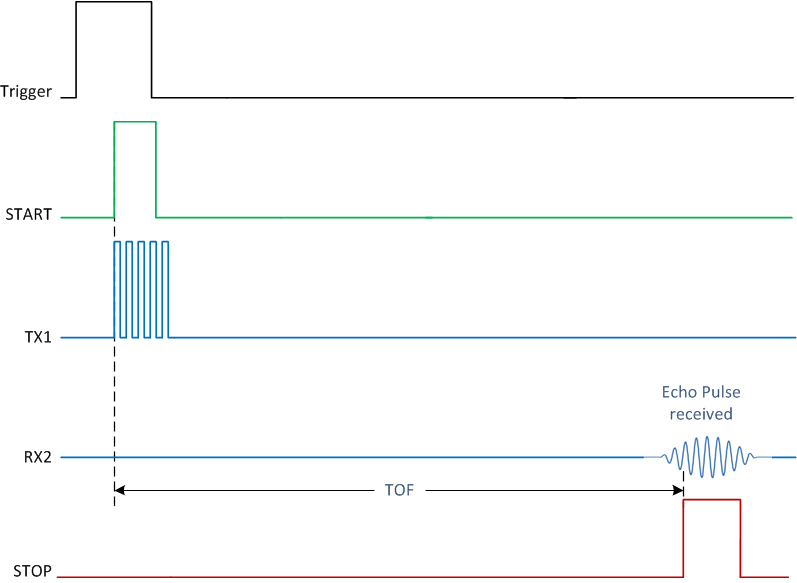SNAS648C October 2014 – February 2023 TDC1000
PRODUCTION DATA
- 1 Features
- 2 Applications
- 3 Description
- 4 Revision History
- 5 Pin Configuration and Functions
- 6 Specifications
- 7 Parameter Measurement Information
-
8 Detailed Description
- 8.1 Overview
- 8.2 Functional Block Diagram
- 8.3 Feature Description
- 8.4 Device Functional Modes
- 8.5 Programming
- 8.6 Register Maps
- 9 Application and Implementation
- 10Device and Documentation Support
- 11Mechanical, Packaging, and Orderable Information
9.2.1.2.1 Level Measurements
For level sensing applications, the total time-of-flight (TOF) of the sound wave in the fluid is measured. The pulses transmitted by transducer B travel through the fluid, typically from the bottom, to the surface of the fluid. The discontinuity between the fluid and air generates a reflected wave which returns back to transducer B.
At the beginning of a measurement cycle, the transducer is connected to a transmit channel of the AFE, and the transmit burst excites the transducer to generate an ultrasound wave. Synchronous to the TX burst, a START pulse is generated by the TDC1000 to indicate the start of a measurement. After the transmission is completed, and depending on the device configuration, the transducer is connected to a receive channel of the AFE.
When a valid echo is received, the TDC1000 generates a STOP pulse. Generation of multiple STOP pulses is possible through register configuration of the device. The START and STOP signal times are compared to determine the TOF.
The level of the fluid can be determined using the following equation:

where
- d is the fluid level in meters (m)
- TOF is the time-of-flight in seconds (s)
- c is the speed of sound in the fluid in meters per second (m/s)
 Figure 9-2 Relation Between Transmit and Receive Pulses in Level Measurements
Figure 9-2 Relation Between Transmit and Receive Pulses in Level MeasurementsLevel measurements have two main criteria: resolution and range (maximum height). Resolution accuracies of 1 mm to 2 mm are achievable but are impractical due to any environmental disturbances, such as tank vibrations, creating millimeter level surface waves. Ranges of up to 1 m are measurable using VDD level excitation pulses, but surface disturbances and signal loss over longer distances make the reliable echo reception an issue. Greater level measurement reception can be achieved by mechanical means (level guide tube) or electronic means (level shifting the TX pulses to greater voltages; see TIDA-00322).